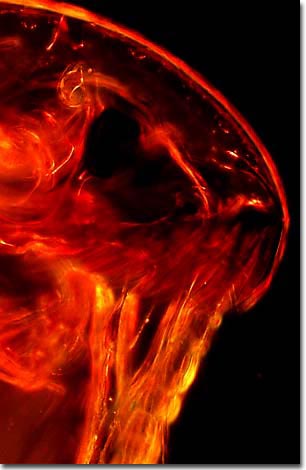Darkfield Microscopy Image Gallery
Flea Head
The head of an ordinary dog flea (Ctenocephalides canis) was captured under darkfield illumination with a Nikon Optiphot microscope using a 10x objective.

Fleas are a relentless summer pest throughout the world, but some species can persist through the winter. These hard-bodied insects (difficult to crush with the bare hand) grow to a size between 1/16 and 1/8 inch by sucking blood from their hosts. The photomicrograph above illustrates the cluster of mouth parts used by the flea to feed on animals.
Adults vary in length from 0.04 to 0.4 inches (1 to 10 millimeters). Fleas are able to jump over eight inches, which is roughly the equivalent of a human jumping over the Statue of Liberty. Specialized anatomical structures allow them to attach to the skin of their hosts, but they pass easily from one host to another. Consequently, fleas can transmit a number of diseases. Most notably, the flea is responsible for transmitting the Black Death, bubonic plague, which killed a quarter of the population of Europe during the Middle Ages. Today the flea is known to transmit tapeworm and haemobartonellosis, a blood disorder that can be fatal to cats. Serious infestations can cause severe inflammation, intense itching and even anemia. Also, a number of pets, as well as people, have allergies to flea saliva that can result in rashes and hair loss.
The flea's life cycle consist of four stages: egg, larva, pupa and adult. Eggs are laid on the body of the host animal, but since they aren't sticky they can drop in any number of places. The larva resembles a small legless caterpillar and it feeds on dried excrement, dried bits of skin, dead mites, dried blood, and other organic debris. Fecal matter from the parent flea is essential to the successful metamorphosis of some species of flea larvae. During this time the parent flea consumes a great deal of blood, up to 30 times its own weight, to produce a large quantity of feces for its larvae. After three molts, the larvae spin a silk cocoon that begins the pupal stage. The pupae emerge as adults days, weeks, or even months later. If conditions are unfavorable, a cocooned flea can remain dormant for up to a year, waiting for warm-blooded creatures to prey upon. At any given time, only five percent of living fleas are in adult form, while most are in the egg, larva, or pupa stages. The life span of adult fleas varies from several weeks to over a year.
